Lallart M. (ed.) Ferroelectrics - Physical Effects
Подождите немного. Документ загружается.


18
Ferroelectric Liquid Crystals Composed of
Banana-Shaped Thioesters
Stanisław Wróbel
1
, Janusz Chruściel
2
, Marta Wierzejska-Adamowicz
1
,
Monika Marzec
1
, Danuta M. Ossowska-Chruściel
2
,
Christian Legrand
3
and Redouane Douali
3
1
Institute of Physics, Jagiellonian University, Kraków
2
Institute of Chemistry, Siedlce University of Natural Sciences and Humanities, Siedlce
3
Université du Littoral Côte d'Opale, LEMCEL, Calais
1,2
Poland
3
France
1. Introduction
Thermotropic liquid crystals composed of rod like molecules are known as calamitic liquid
crystals. Flatten molecules of some organic compounds form discotic liquid crystals. Both
kinds of compounds may exhibit nematic phase. Calamitic mesogens may also form
lamellar smectic structures being so important for living systems, whereas discotic
molecules make columnar mesophases. Banana-shaped (bow-shaped or bent-core)
ferroelectric liquid crystals have been discovered in the last decade of the 20-th century
(Noiri et al., 1996). Since then there has been a great interest in their dielectric and electro-
optic properties due to potential applications (Sekine et al., 1997; Link et al., 1997; Pelzl et al.,
1999). At the beginning some of the bent-core compounds were not chemically stable
enough as to study them experimentally during cooling and heating runs in long lasting
experiments (Wróbel et al., 2000). It came out that bent-core achiral thioesters are very stable
materials showing either B
1
or B
2
phase (Rouillon et al., 2001; Ossowska-Chruściel, 2007,
2009). In this article we present complementary studies on B
1
and B
2
phases of 1,3-phenylene
bis{4-[(4-alkoxybenzoyl)-sulfanyl]benzoates} (in short: nOSOR) having achiral symmetric
bent-core molecules shown in Fig. 1.
Fig. 1. Molecular structure of the symmetric thioester compounds studied
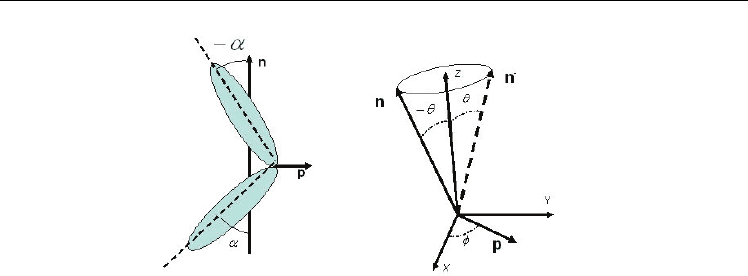
Ferroelectrics – Physical Effects
430
(a) (b)
Fig. 2. (a) Simplified model of bent-core molecule and two directors n and p, (b) Primary n
and secondary p directors in the (X,Y,Z) laboratory reference frame. In B
2
phase the n
director is tilted with respect to the smectic plane normal Z by the angle +
θ
or -
θ
. The n
director is the average direction of the long molecular axis. The secondary director p is the
average position for the short molecular in-plane axis. The other short axis is perpendicular
to the (n, p) plane.
Because of the tilt sign ( + or -) of the n director (Fig. 2 (b)) and two directions of the p polar
director (+p and – p) there are four different structures of B
2
phase: 1. Synclinic ferroelectric
(SmC
S
P
F
) – the tilt angle is positive or negative in all smectic layers and p vectors are
parallel, 2. Synclinic antiferroelectric (SmC
S
P
A
), 3. Anticlinic ferroelectric (SmC
A
P
F
), and 4.
Anticlinic antiferroelectric (SmC
A
P
A
). The last one shows up for two symmetric compounds
(12OSOR and 14OSOR) studied in this work. A general symbol of B
2
phase can be written as
follows: SmC
SA
P
FA
, where index “S” stands for synclinic, A – for anticlinic order of
molecules in two neighboring layers, F – for ferroelectric and A – antiferroelectric order of
polarization vectors.
Banana-shaped compounds may form both lamellar and/or columnar mesophases
(Szydłowska, 2003) that have become a subject of intensive experimental (Reddy &
Tschierske, 2006) and theoretical studies (Vaupotič, 2006) in the last decades. In the first
place research on electro-optic switching in ferro- and anti-ferroelectric phases composed of
bent-core molecules has been done because of possible practical applications (Walba el al.,
2000; Reddy & Tschierske, 2006).
Since the discovery of ferroelectric order in smectic B phases composed of polar achiral
banana-shaped molecules many experimental studies have been done that confirm ferro- or
antiferroelectric order inside the layers and positive (ferroelectric) or negative
(antiferroelectric) correlations between the layers. Theoretical studies were focused on inter-
molecular interactions within the layers as well as interlayer correlations (Vaupotič & Čopič
, 2005; Vaupotič, 2006).
Liquid crystalline materials built of bent-core molecules are also attractive because they
exhibit new physical properties. They possess two-dimensional smectic phases that display
qualitatively different physical properties than the calamitic ferroelectric liquid crystals
(Pelzl, 1999; Reddy & Tschierske, 2006). Bent–core non-chiral molecules show tendency to
form a polar order within the smectic layers. Using a dielectric spectroscopy method it was
found (Kresse et al., 2001, Kresse, 2003) that the reorientation of polar molecules is strongly

Ferroelectric Liquid Crystals Composed of Banana-Shaped Thioesters
431
hindered in B
2
phase because of dense packing of bent-core molecules in smectic layers. Due
to this the secondary order parameter (spontaneous polarization) is almost temperature
independent.
Thin Langmuir-Bloggett films composed of bent-core molecules studied by reversal current
method (Geivandov, 2006) reveal an interesting property that polarization of nano-layers is
similar to bulk polarization. Both ferro- and anti-ferroelectric order have been observed. It
was also found for nano-layers that the molecules are mobile in such restricted geometry
what facilitates both ferro- and antiferroelectric switching.
Out of eight B phases: B
1
, B
2
, B
3
, …, B
7
, and
B
8
(Reddy & Tschierske, 2006) the most
thoroughly investigated seems to be the B
2
phase which may show one of four types of
order depending on the sign of tilt angle (+
θ
or -
θ
) as well as on the sign of correlations
(positive – ferroelectric order or negative – antiferroelectric order) between the polarization
vectors of neighboring layers (∼P
j
⋅P
j+1
). Complementary studies performed on a few
homologous series show that compounds with shorter side chains (C
5
– C
9
) exhibit only a
frustrated B
1
phase, whereas those having longer chains (C
10
– C
14
) generally display
antiferroelectric B
2
phase (Bedel et al., 2000).
The main objective of this article is to present dielectric and electro-optic behavior of B
1
or B
2
phases of four selected members of nOSOR series (n=8, 9, 12 and 14). The first two show
only B
1
phase, and the other two with even number of carbon atoms in the side alkoxy
chains display only B
2
phase of SmC
A
P
A
type.
2. Experimental methods
To study phase transitions and physical properties of B
1
and B
2
phases the following
complementary methods have been employed: DSC calorimetry, polarizing microscopy
texture observation, linear dielectric spectroscopy, and reversal current method. Using the
latter it was possible to record the reversal current spectra for the B
2
phase in form of two
well separated current peaks what substantiates antiferroelectric order of this phase. As also
found, the B
1
exhibits also some kind of ferroelectric order which is being gradually reduced
upon temperature decreasing (Wierzejska-Adamowicz, 2010; Chruściel, 2011).
2.1 DSC calorimetric studies
Thermal properties of the substances investigated have been studied by differential
scanning calorimetry using Pyris1 DSC made by Perkin Elmer Company. Transition
temperatures and enthalpies of the transitions have been computed based on DSC heating
and cooling thermograms. Fig. 3 presents DSC results for 8OSOR compound which
possesses enantiotropic B
1
phase showing up during cooling in a wide temperature range of
40 degrees. As one can see the melting process of this material is complex – on heating there
are two transitions (Cr-Cr
2
-Cr
1
) between solid modifications. Below the B
1
enantiotropic
phase there seems to be an orientationally disordered crystal (ODIC).
As an example endothermic and exothermic curves are shown in Fig. 4 for 12OSOR. It is
seen that the B
2
phase is also enantiotropic one. On heating two crystalline modifications
(Cr
1
and Cr
2
) were found. One should point out that all compounds studied in this work
are thermally very stable – their clearing points do not change after a few heating and
cooling runs.
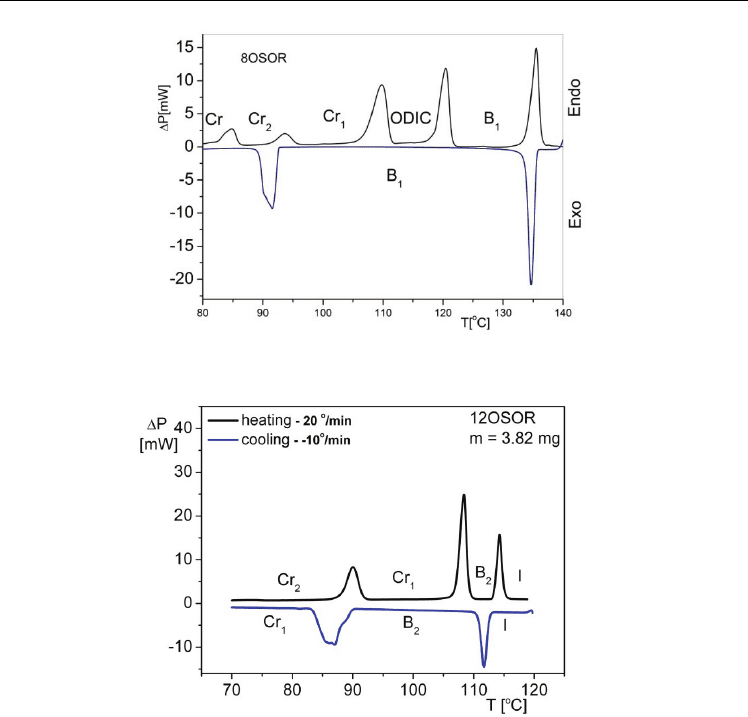
Ferroelectrics – Physical Effects
432
Fig. 3. Endothermic and exothermic runs obtained by Pyris 1 DSC for 8OSOR compound
Fig. 4. DSC results obtained for 12OSOR compound on cooling and heating by using Pyris1
DSC
Studies of the physical properties of all compounds have been performed on cooling. The
transition temperatures acquired by DSC method on cooling are as follows:
8OSOR - I 133.4 °C (16.9) → B
1
92.7 °C (14.7) → Cr
1
9OSOR - I 123.4 °C (16.0) → B
1
82.6 °C (14.0) → Cr
12OSOR - I 112.6 °C (18.5) → B
2
88.6 °C (38.7) → Cr
1
14OSOR - I 114.6 °C (17.4) → B
2
87.2 °C (57.6) → Cr
Transition enthalpies for the clearing and freezing points are given in round brackets in
[kJ/mol]. As seen there are small differences between the clearing and freezing enthalpies
for the first two homologs with B
1
phase.
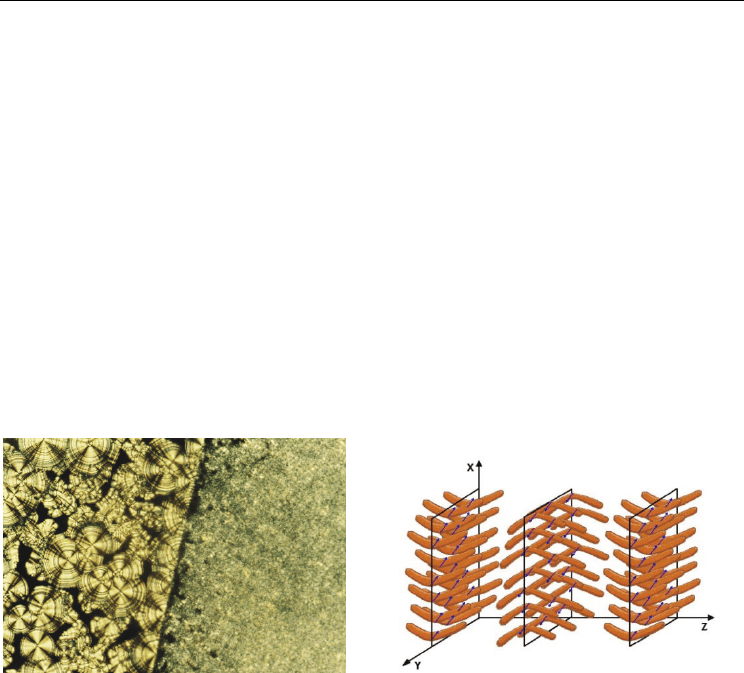
Ferroelectric Liquid Crystals Composed of Banana-Shaped Thioesters
433
2.2 Electro-optic methods
Texture observation and electro-optic switching between the planar and homeotropic
textures for 12OSOR were done at LEMCEL using Olympus Polarizing Microscope BX60
and LINKAM temperature controller. Texture observations of 8OSOR, 9OSOR, 12OSOR,
and 14OSOR were performed using Nikon Eclipse Polarizing Microscope LV100POL and
INSTEC temperature controller in the Institute of Physics of the Jagiellonian University.
Polarizing microscopy measurements allowed us to identify phases and to observe a planar
inhomogeneous (Fig. 5(a)) and homeotropic textures of B
2
phase. The homeotropic texture
(Fig. 6 (a)) was observed after applying bias field equal to 26 V
p-p
/µm. Figs. 5 (b) and 6 (b)
present schematic molecular arrangements of the local planar and homeotropic alignments,
respectively. Due to the splay deformation (Takanishi, 2003; Vaupotič, 2005) the texture is
planar inhomogeneous (quasi-planar) with characteristic circular domains (Fig. 5 (a)). Under
strong electric field (26 V
p-p
/µm) a fast transition to homeotropic texture is observed with
secondary optical axis being perpendicular to the electrodes. Using triangular driving field
at a certain voltage value a completely black homeotropic state was observed. Similar
electro-optic behavior has been found for 14OSOR (Wierzejska-Adamowicz, 2010,
Wierzejska-Adamowicz et al., 2010).
(a) (b)
Fig. 5. (a) Planar texture of 12OSOR’s B
2
phase obtained at T=116.8°C, U=0 V
p-p
/µm, AWAT
HG cell – d=1.7 µm and (b) schematic local alignment of molecules in planar B
2
phase.
This shows undoubtedly that there is an electro-optic switching between the two states
SmC
A
P
A
→SmC
S
P
F
. Upon applying triangular voltage wave the extinction directions of the
characteristic circular domains (Fig. 5 (a)) reorient clockwise or counterclockwise depending
on the field direction what was observed for symmetric (Walba et al., 2000; Sadashiva et al.,
2000; Zhang et al., 2006) and asymmetric (Lee et al., 2010) banana-shaped systems. However,
it was not possible to grow a mono-domain of uniform planar alignment even upon
applying strong electric fields. Inhomogeneous planar texture (Fig. 5 (a)) was, consisting of
Maltese crosses originated from concentric layer structures,was observed. Such structures
were revealed by X-ray diffraction (Takanishi, 2003). Characteristic brushes forming Maltese
crosses (Ortega et al., 2004) coincide with the polarizer-analyzer positions due to anticlinic
order of molecules in two neighboring layers forming a pseudo-unit cell. The authors were
able to grow B
2
phase after applying a strong electric field to B
1
phase.

Ferroelectrics – Physical Effects
434
(a) (b)
Fig. 6. (a). Quasi-homeotropic texture of 12OSOR’s B
2
phase observed at T=116.8°C, U=26
V
p-p
/µm, AWAT HG cell – d=1.7 µm and (b) schematic local alignment of molecules in
homeotropic B
2
phase. Electric field is parallel to the X-axis. It is worth pointing out that
upon applying triangular voltage wave a completely black state (homeotropic) was
observed at a certain voltage value.
It is worth noting that the characteristic mosaic texture of B
1
phase does not change at all
under A.C. field and electro-optic switching is not observed (Ossowska-Chruściel, D.M. et
al., 2007; Wierzejska-Adamowicz, 2010). Spontaneous polarization measurements were
carried out – by means of reversal current method - using 1.7 μm and 3.2 μm AWAT HG
ITO cells for 9OSOR and 12OSOR, respectively. The experimental set-up consists of
Fig. 7. Reversal current peaks obtained for antiferroelectric B
2
phase of 12OSOR at different
driving voltages – from threshold to saturation voltage (see also Fig. 9). The real value of the
driving voltage was equal to U
o
×20 V
p-p
Agilent 3310A wave form generator, FLC Electronics amplifier F20ADI and digital scope
Agilent DSO6102A.
The B
2
phases of 12OSOR and 14OSOR compounds are anticlinic and antiferroelectric
(SmC
A
P
A
), so after applying to the electrodes a triangular wave two peaks are observed as
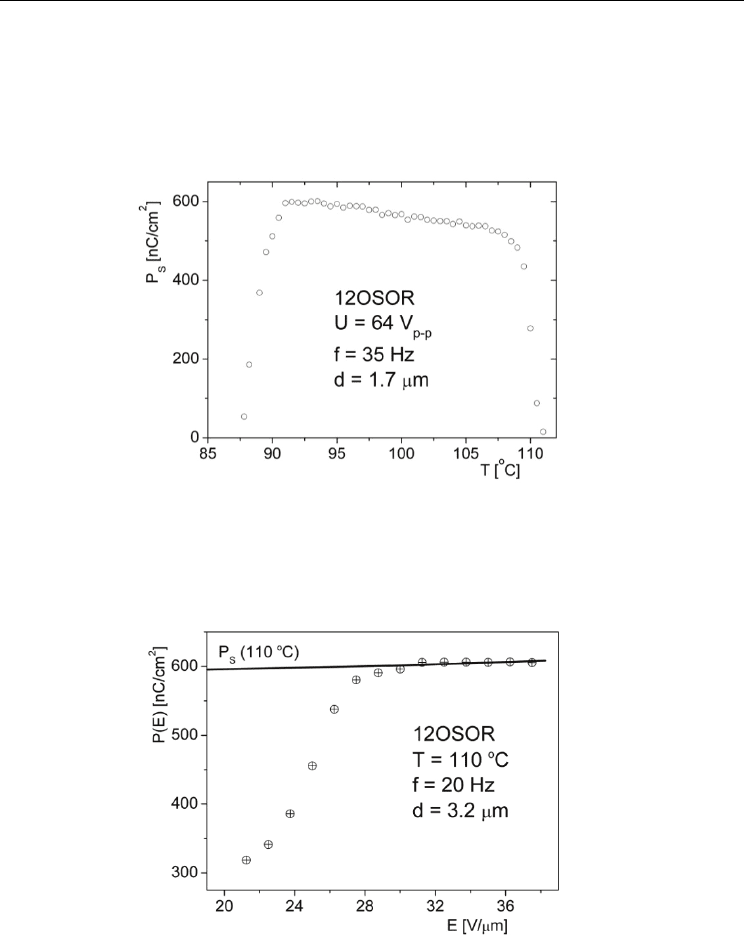
Ferroelectric Liquid Crystals Composed of Banana-Shaped Thioesters
435
the current response of the sample in half a period of the driving voltage (Fig. 7). As seen in
Fig. 8 spontaneous polarization of 12OSOR is very high - it reaches a value close to 600
nC/cm
2
and is weakly temperature dependent in the B
2
phase. The measurements were
done applying driving electric field of 35 Vp-p/μm and frequency of 20 Hz. Spontaneous
polarization of 14OSOR is slightly smaller and its temperature dependence is also weak
(Chruściel, 2011)
Fig. 8. Spontaneous polarization of B
2
phase vs. temperature for 12OSOR compound
As seen in Fig. 9 the polarization of B
2
phase depends non-linearly on electric field. Above
30V
p-p
/μm it becomes saturated reaching the value of spontaneous polarization. In addition
this non-linear dependence begins above the threshold field (ca. 21 Vp-p/μm at 110
°
C)
Fig. 9. Polarization vs. electric field of 12OSOR’s B
2
phase at selected temperature of 110 °C
As seen in Figs. 8 and 9 the B
2
phase of 12OSOR exhibits large spontaneous polarization. As
found before the B
2
phases composed of bent-core asymmetric molecules (Kohout et al.,
2010) show distinctly smaller spontaneous polarization (from 200 to 380 nC/cm
2
) but upon
cooling ferroelectric – antiferroelectric transition was observed.
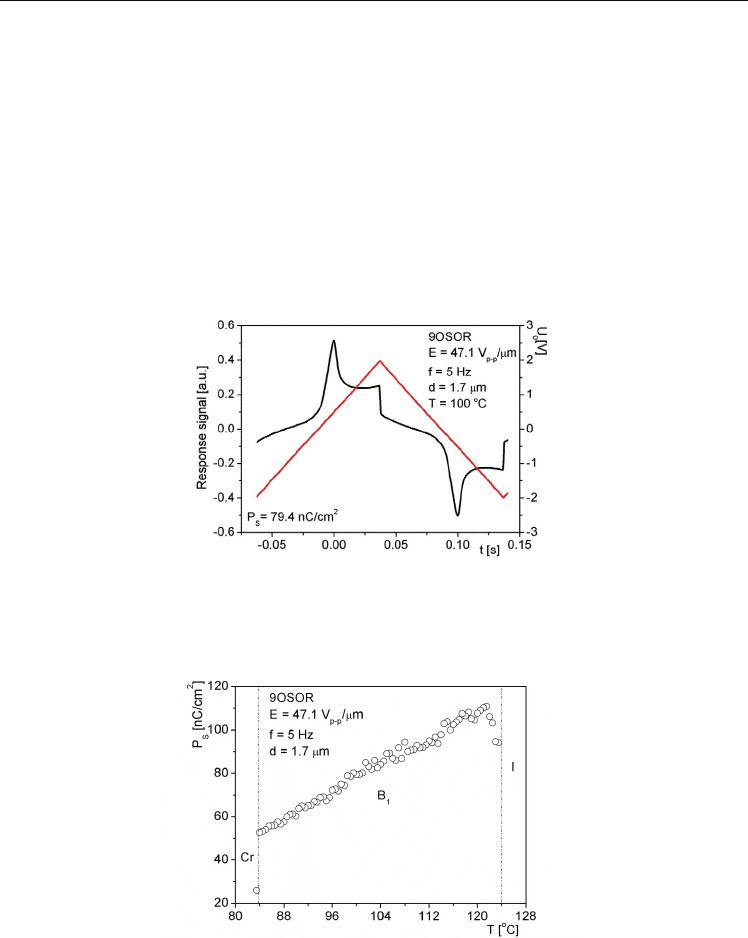
Ferroelectrics – Physical Effects
436
As known, in B
1
phase the side alkoxy chains of the molecules in one layer overlap on the
cores of molecules in neighboring layers and there is a compensation of microscopic
polarization (Reddy & Tschierske, 2006). However, using strong electric field one can induce
polarization in this phase (Figs. 10 and 12) due to positive short range order of dipole
moments inside the layers.
The B
1
phase of 9OSOR shows a reasonable reversal current response (Fig. 10) which is typical
for switching polarization vector from +P
s
to - P
s
in ferroelectrics. However, the temperature
dependence of spontaneous polarization (Fig. 11) is not like that for a ferroelectric or
antiferroelectric phase of classical ferroelectric liquid crystals (Wróbel et al., 2003). It can be
treated as an induced polarization originating from molecular polar clusters created due to
steric interactions inside the layers. It decreases with temperature decreasing due to inter-
and/or intra-layer negative dipole-dipole correlation which are stronger at low temperatures.
Fig. 10. Triangular driving voltage (right-hand side scale) applied vs. time and reversal current
spectrum (left-hand side scale) of B
1
phase of 9OSOR acquired for E = 47.1 V
p-p
/μm, f = 5 Hz, d
= 1.7 μm and at T = 100°C. The real value of the driving voltage was equal to U
o
×20 V
p-p
Fig. 11. Polarization of 9OSOR’s ferroelectric B
1
phase vs. temperature. Measurement
conditions: triangular voltage wave - E = 47.1 V
p-p
/μm, f = 5 Hz, d = 1.7 μm
As found before by the dielectric relaxation spectroscopy, in the B
1
phase there exists
antiparallel dipole-dipole correlation of transverse dipole moments (Kresse et al., 2001; Kresse,
2003). There is also a strong retardation of molecular reorientational motions at the I-B
1
(or B
2
)
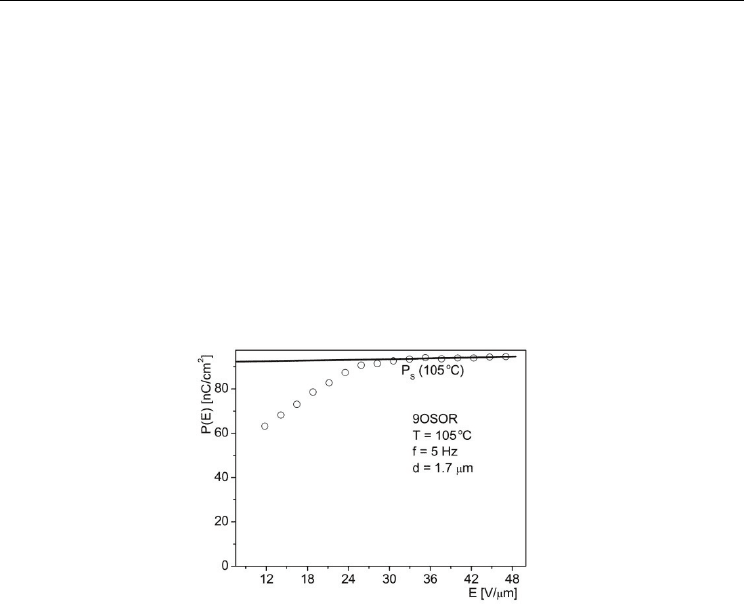
Ferroelectric Liquid Crystals Composed of Banana-Shaped Thioesters
437
phase transition which is being caused by high order of bent-core molecules in B phases. Large
value of the transition enthalpies for the transition between the isotropic and liquid crystalline
phase of these materials as well as weak temperature dependence of the spontaneous
polarization of B
2
phase also substantiate high order of B phases. As one can additionally
notice the enthalpy changes of melting and freezing points (Figs. 3 and 4) are distinctly smaller
than those obtained for calamitic liquid crystals what reflects a distinctly smaller change of
order between liquid crystalline and crystalline phase of bent-core systems.
It has been found in this study that the polarization of B
1
phase changes non-linearly with
electric field applied (Fig. 12) yet it does not reach such large values as those obtained for
the B
2
phase. Like for B
2
phase (Fig. 9) there is a threshold field of ca. 12 V/μm, above which
a single reversal current peak shows up (Fig. 10), and above 25 V/μm the polarization of B
1
phase saturates but its value is smaller than 120 nC/cm
2
. This effect is most probably due to
short range ferroelectric order and/or modulated structures (Szydłowska, 2003).
Fig. 12. Polarization vs. electric field applied to the sample of 9OSOR’s ferroelectric B
1
phase.
Parameters: frequency of the driving voltage - f = 5 Hz, thickness of the sample d = 1.7 μm.
2.3 Dielectric spectroscopy
Dielectric measurements were done using dielectric spectrometer based on Agilent 4294A
precision impedance analyzer controlled by PC using a program written on
VisualStudio.NET platform. Substances were put by means of capillary action into HG -
5μm AWAT cells with gold electrodes. The dielectric spectrometer allows one to measure
dielectric spectra with high accuracy. The measurements have been done using the cells
with gold electrodes covered with rubbed polymer layers what facilitates planar but for
banana-shaped molecules inhomogeneous alignment. The dielectric spectra were acquired
in the frequency range from 40 Hz to 25 MHz. More than 60 experimental points were
acquired per one frequency decade. Bias field was used to align the biaxial B
2
phase so that
the polar director p is perpendicular to the electrodes. The B
2
is a biaxial phase having the
dielectric permittivity tensor of the form:
*
1
**
2
*
||
() 0 0
ˆ
() 0 () 0
00()
⊥
⊥
⎛⎞
εω
⎜⎟
⎜⎟
εω= ε ω
⎜⎟
⎜⎟
ε
ω
⎝⎠
(1)
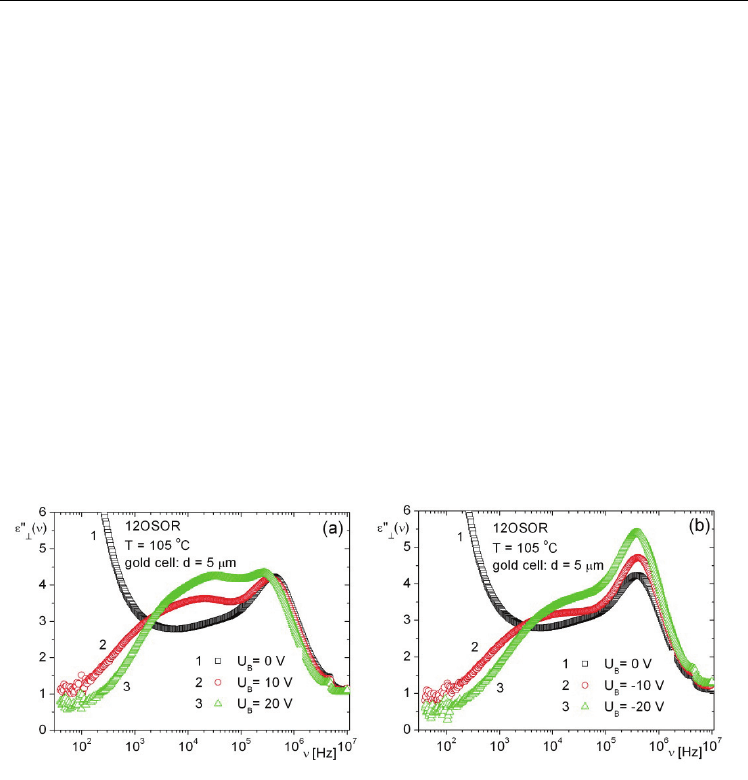
Ferroelectrics – Physical Effects
438
In this study it was possible to measure two principal components of this tensor, namely
*
1
()
⊥
εω
and
*
2
()
⊥
εω
, where the latter was measured along the secondary optical axis. The
difference:
ε
⊥
2
- ε
⊥
1
≡δε (2)
can be treated as a measure of biaxiality (Lagerwall, 1998) of the B
2
phase. It has been shown
by means of the dielectric spectroscopy (Ossowska-Chruściel et al., 2009; Wierzejska-
Adamowicz et al., 2010; Chruściel, 2011) that with electric measuring fields being parallel to
the polar director
p one observes an enhanced dielectric absorption and electric permittivity
as well. As found in scope of this work there is an asymmetry of the dielectric spectra
between the positive and negative bias fields (Fig. 13 (a) and (b)). It means that the system
studied has low point symmetry. B phases composed of bow-shaped molecules may exhibit
one of the following low point symmetries:
C
2V
, C
2h
, C
2
and even C
1
(Pelzl et al., 1999).
Exemplary dielectric spectra – obtained vs. bias field - are presented in Figs. 13 (a) and (b).
As seen there is an asymmetry of the dielectric spectra – the intensity of dielectric absorption
depends on the sign of bias voltage. The dielectric absorption of the high frequency
dielectric relaxation process is distinctly larger for negative bias fields. On the other hand,
the low frequency dielectric relaxation process is being stronger enhanced for positive than
negative bias fields (Fig. 13 (a)).
Fig. 13. Bias field dependences of dielectric spectrum measured for B
2
phase of 12OSOR. (a)
Dielectric spectra for positive and (b) negative bias voltages
The B
2
phase is biaxial with the director n and polar director p. Using strong electric fields it
was possible to observe in A.C. electric field transitions between a quasi-planar and
homeotropic state with polar director
p being normal to the electrodes. Using our HG gold
cells and the experimental conditions it was not possible to study the dielectric spectrum of
the B
2
phase aligned homeotropically with primary director n being parallel to electric
measuring field.
2.3.1 Bias field influence
The dielectric spectra were processed by using ORIGIN 7.0 software. The following complex
function was fit to the experimental points measured without bias field:
